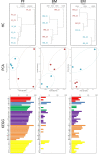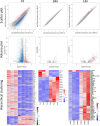Receptor Tyrosine Kinase Inhibitor Sunitinib as Novel Immunotherapy to Inhibit Myeloid-Derived Suppressor Cells for Treatment of Endometriosis
- PMID: 34367125
- PMCID: PMC8340010
- DOI: 10.3389/fimmu.2021.641206
Receptor Tyrosine Kinase Inhibitor Sunitinib as Novel Immunotherapy to Inhibit Myeloid-Derived Suppressor Cells for Treatment of Endometriosis
Abstract
Endometriosis is a common, benign, and hormone-dependent gynaecological disorder that displays altered immunoinflammatory profiles. Myeloid-derived suppressor cells (MDSCs) suppressed immunosurveillance in endometriosis in human and mouse model. Receptor tyrosine kinase inhibitor Sunitinib can induce MDSC apoptosis and suppress the progression of cancer. However, the effects of Sunitinib on MDSCs in endometriosis and the underlying mechanism are not clear. In this study, we employed an animal study of the endometriosis model in mice for treatment of Sunitinib. After syngeneic endometrium transplantation and treatment, endometriotic lesion volume, weight, and histology were compared. Peritoneal fluid, peripheral blood, and bone marrow MDSC subsets and their molecular signaling were monitored by flow cytometry. Peritoneal cytokines were assayed by ELISA. The gene expression profiles of isolated CD11b+Ly6G+Ly6Clo cells were studied by RNA sequencing. We found that Sunitinib significantly decreased the endometriotic lesion size and weight after 1 and 3 weeks, and decreased p-STAT3 activation in MDSCs after 1 week of treatment. In the first week, Sunitinib specifically increased the G-MDSC population in peritoneal fluid but the isolated CD11b+Ly6G+Ly6Clo MDSCs after Sunitinib treatment were presented as mature polynuclear MDSCs, while the control group had immature mononuclear MDSCs. Importantly, we found Sunitinib differentially suppressed gene expressions of immunosuppressive function and differentiation in peritoneal G-MDSCs. Apelin signaling pathway associated genes and inflammation related genes were upregulated, and amino acid metabolism regulator genes were downregulated in bone marrow G-MDSCs. For endometriotic lesions, the PPARG gene governing glucose metabolism and fatty acid storage, which is important for the development of endometriosis was upregulated. In conclusion, Sunitinib inhibited endometriotic lesions, by promoting peritoneal fluid MDSCs maturation and inhibiting the immunosuppressive function. These findings suggest that Sunitinib changed the immune microenvironment and inhibited the development of endometriosis, which has potential therapeutic effects as novel immunotherapy to promote MDSCs maturation, differentiation, and metabolism for the treatment of endometriosis.
Keywords: Sunitinib; endometriosis; gene expressions; immunosuppression; myeloid-derived suppressor cells.
Copyright © 2021 He, Hung, Liang, Zhang, Gao, Chu, Zhang, Xu, Chung and Wang.
Conflict of interest statement
The authors declare that the research was conducted in the absence of any commercial or financial relationships that could be construed as a potential conflict of interest.
Figures





Similar articles
-
Cryptotanshinone alleviates immunosuppression in endometriosis by targeting MDSCs through JAK2/STAT3 pathway.Phytomedicine. 2025 Jan;136:156227. doi: 10.1016/j.phymed.2024.156227. Epub 2024 Nov 14. Phytomedicine. 2025. PMID: 39580997
-
MDSCs drive the process of endometriosis by enhancing angiogenesis and are a new potential therapeutic target.Eur J Immunol. 2018 Jun;48(6):1059-1073. doi: 10.1002/eji.201747417. Epub 2018 Mar 13. Eur J Immunol. 2018. PMID: 29460338 Free PMC article.
-
CD33+ CD14+ CD11b+ HLA-DR- monocytic myeloid-derived suppressor cells recruited and activated by CCR9/CCL25 are crucial for the pathogenic progression of endometriosis.Am J Reprod Immunol. 2019 Jan;81(1):e13067. doi: 10.1111/aji.13067. Epub 2018 Nov 16. Am J Reprod Immunol. 2019. PMID: 30375700
-
Signal transducer and activator of transcription proteins: regulators of myeloid-derived suppressor cell-mediated immunosuppression in cancer.Arch Pharm Res. 2016 Nov;39(11):1597-1608. doi: 10.1007/s12272-016-0822-9. Epub 2016 Aug 29. Arch Pharm Res. 2016. PMID: 27572156 Review.
-
Suppressive role of myeloid-derived suppressor cells (MDSCs) in the microenvironment of breast cancer and targeted immunotherapies.Oncotarget. 2016 Sep 27;7(39):64505-64511. doi: 10.18632/oncotarget.11352. Oncotarget. 2016. PMID: 27542274 Free PMC article. Review.
Cited by
-
Ligustrazine inhibits inflammatory response of human endometrial stromal cells through the STAT3/IGF2BP1/RELA axis.Pharm Biol. 2023 Dec;61(1):666-673. doi: 10.1080/13880209.2023.2195883. Pharm Biol. 2023. PMID: 37095705 Free PMC article.
-
Cancer Immunotherapy with "Vascular-Immune" Crosstalk as Entry Point: Associated Mechanisms, Therapeutic Drugs and Nano-Delivery Systems.Int J Nanomedicine. 2024 Jul 19;19:7383-7398. doi: 10.2147/IJN.S467222. eCollection 2024. Int J Nanomedicine. 2024. PMID: 39050878 Free PMC article. Review.
-
Construction of a clinical predictive model for risk factors after laparoscopic surgery in patients with endometriosis based on pathologic characteristics.Am J Transl Res. 2025 May 15;17(5):3392-3403. doi: 10.62347/PINL7923. eCollection 2025. Am J Transl Res. 2025. PMID: 40535644 Free PMC article.
-
Novel in vivo endometriotic models associated eutopic endometrium by implanting menstrual blood-derived stromal cells from patients with endometriosis.Sci Rep. 2023 May 23;13(1):8347. doi: 10.1038/s41598-023-35373-4. Sci Rep. 2023. PMID: 37221282 Free PMC article.
-
Catamenial Pneumothorax-Still an Unveiled Disease.Medicina (Kaunas). 2024 Dec 9;60(12):2029. doi: 10.3390/medicina60122029. Medicina (Kaunas). 2024. PMID: 39768909 Free PMC article. Review.
References
Publication types
MeSH terms
Substances
LinkOut - more resources
Full Text Sources
Other Literature Sources
Medical
Research Materials
Miscellaneous

